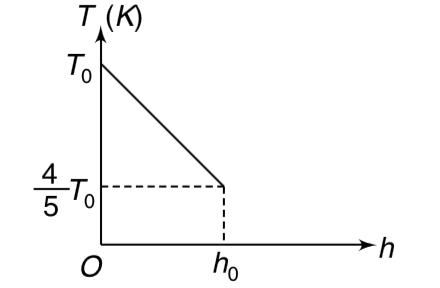Assume that the temperature remains essentially constant in the upper part of the atmosphere. Obtain an expression for the variation in pressure in the upper atmosphere with height, the mean molecular weight of air is M.
Suppose the pressure at height h is p and that at h+dh is p+dp. Then
dp=−ρgdh
pV=nRT=mMRT
p=ρRTM⇒ρ=pMRT
dp=−pMRTgdh
p∫p0dpp=−MgRTh∫0dh
lnpp0=−MghRT
p=p0e−MghRT
Topper's Solved these Questions
Similar Questions
Assume that the temperature remains essentially constant in the upper part of the atmosphere. Obrain an epression for the variation in pressure in the upper atmosphere with height, the mean molecular weight of air is M.
View Solution(a) Assume the atmosphere as an ideal gas in static equilibrium at constant temperature T0. The pressure on the ground surface is P0. The molar mass of the atmosphere is M. Calculate the atmospheric pressure at height h above the ground.
(b) To be more realistic, let as assume that the temperature in the troposphere (lower part of the atmosphere) decreases with height as shown in the figure. Now calculate the atmospheric pressure at a height h0 above the ground.
 View Solution
View Solution
Knowledge Check
- Question 1 - Select One
Assume that the temperature remains essentially constant in the upper parts of the atmosphere. The atmospheric pressure varies with height as. (the mean molecular weight of air is M, where P0= atmospheric pressure at ground reference)
APe−3Mgh2RTBP0e−Mgh2RTCP0e−3MghRTDP0eMghRT - Question 2 - Select One
Normally, the temperature decreases with the increase in height from the Earth's surface, because -
1. the atmosphere can be heated upwards only from the Earth's surface
2. there is more moisture in the upper atmosphere
3. the air is less dense in the upper atmosphere
Select the correct answer using the codes given below:Al onlyB2 and 3 onlyC1 and 3 onlyD1, 2 and 3 - Question 3 - Select One
Normally, the temperature decreases with the increase in height from the Earth’s surface because
1. The atmosphere can be heated upwards only from the Earth’s surface.
2. There is more moisture in the upper atmosphere.
3. The air is less dense in the upper atmosphere.
Select the correct answer using the codes given below:A1 onlyB2 and 3 onlyC1 and 3 onlyD1, 2 and 3
Show that the internal energy of the air (treated as an ideal gas) contained in a room remains constant as the temperature changes between day and gight. Assume that the atmospheric pressure around remains constant and the air in the room maintains this prssure by communicating with the surrounding thourgh the widows, doors, etc.
View SolutionDiameter of a planet is 10d∘, its mean density is ρ∘4 and mass of its atmosphere is 10m∘ where d∘, ρ∘ and m∘ are diameter, mean density and mass of atmosphere respectively for the earth. Assume that mean density of atmosphere is same on the planet and the earth and height of atmosphere on both the planets is very small compared to their radius. Find the ratio of atmospheric pressure on the surface of the planet to that on the earth. If a mercury barometer reads 76 cm on the surface of the earth, find its reading on the surface of the planet.
View SolutionWhich of the following statements concerning atmosphere of the Earth are correct?
1. In statosphere, temperature increases with altitude.
2. In mesophere, temperature decreases with altitude.
3. The lowest temperature of the atmosphere is recorded inthe upper part of mesosphere.
4. Tropopause is an isothermal zone.
Select the correct answer using the code given belowView SolutionIn the upper atmosphere the kinetic temperature of air is of the order of 1000 K, even then one feels severe cold there.
View SolutionAn upper air wind system with very high velocities in certain parts of the atmosphere is called :
View Solution

